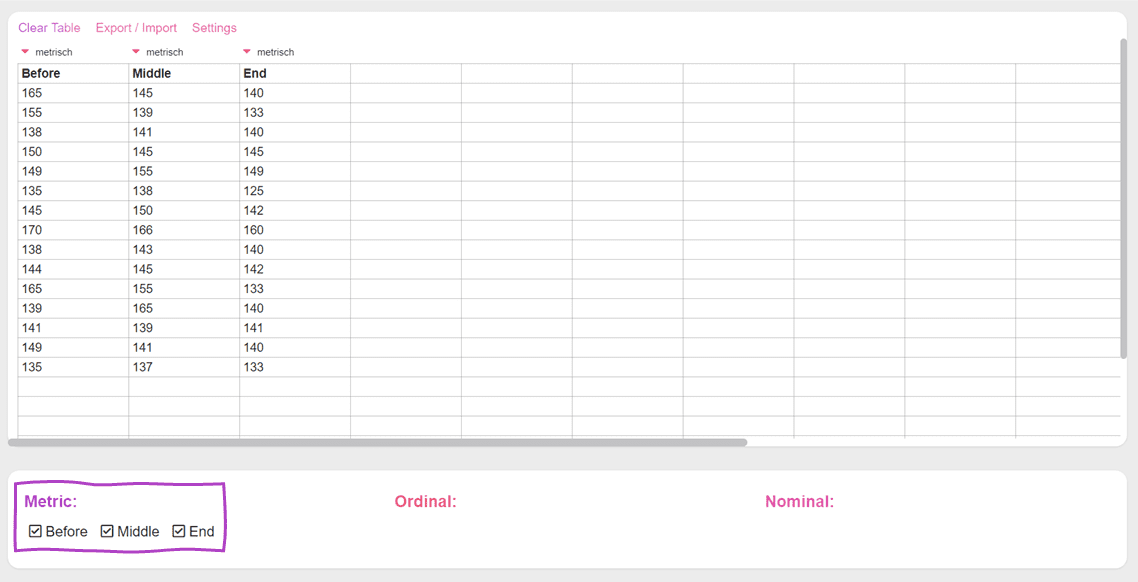Repeated measures ANOVA Calculator
If you want to calculate an analysis of variance with repeated measures, simply select more than three metric variables. Of course, you can also calculate an analysis of variance without repeated measurements, to do this, simply select a metric and a nominal variable with three values.

One-way ANOVA with repeated measures
A one-way ANOVA (Analysis of Variance) with repeated measures is a statistical technique used to analyze the differences between three or more related groups, where each participant or subject is measured multiple times under different conditions or at different time points. This design is often referred to as a "within-subjects" or "within-groups" design because the same participants are included in all the groups being compared.
In a traditional one-way ANOVA, participants are assigned to distinct and independent groups, and their scores are measured only once per group. In contrast, in a one-way ANOVA with repeated measures, participants are exposed to all the conditions or time points, and their responses are measured multiple times. This approach has several advantages, including increased statistical power due to the reduced variability between participants and the ability to control for individual differences.
The basic steps of conducting a one-way ANOVA with repeated measures are as follows:
- Define the research question: Determine the variables and the specific conditions or time points to be compared.
- Collect data: Measure the dependent variable(s) for each participant under each condition or at each time point.
- Perform the ANOVA: Calculate the mean scores for each condition and compare them to identify if there are significant differences.
- Check assumptions: Ensure that the data meet the assumptions of the test, such as normality and sphericity (homogeneity of variances of the differences between all pairs of conditions).
- Interpret the results: If the ANOVA indicates a significant difference, further post hoc tests may be performed to determine which specific conditions or time points differ significantly.
- Report the findings: Present the results in a clear and concise manner, including effect sizes and any relevant post hoc analyses.
It's essential to be cautious about the interpretation of results, especially when dealing with small sample sizes or violations of assumptions, as these can impact the validity of the findings. Additionally, researchers should consider potential sources of bias and make informed decisions about the appropriateness of the repeated measures design for their specific research question.
Mastering Repeated Measures ANOVA: Your Online Calculator Guide
The realm of statistics is vast, but certain techniques stand out when dealing with repeated measurements on the same subjects. One such technique is the Repeated measures ANOVA. And if you're looking to harness the power of this statistical test without the manual number-crunching, our guide to the Repeated measures analysis of variance calculator is your golden ticket.
What is Repeated Measures ANOVA?
At its core, Repeated measures ANOVA is a statistical test that helps determine the effect of different conditions on a single group of subjects. Imagine you're assessing the impact of three different diets on a group of individuals over time. Instead of comparing different individuals for each diet, you assess the same individuals under each diet condition. This is where Repeated measures ANOVA shines.
The Rise of Online Calculators
In our digital age, doing statistics by hand is a thing of the past. Online tools offer efficiency and accuracy, making them an excellent choice for researchers, students, and professionals. With the ability to calculate a Repeated measures ANOVA online, you can:
- Save Time: Skip the tedious manual calculations and get instant results.
- Ensure Accuracy: Minimize human errors and lean on tried-and-true algorithms.
- Access Anywhere: All you need is an internet connection and your data, and you're good to go.
How to Use the Repeated Measures Analysis of Variance Calculator
- Enter Your Data: Most online calculators will guide you through the process, prompting you to input data for each condition or time point.
- Set Your Preferences: Some calculators allow you to adjust significance levels or other parameters. Make sure you set these according to your research needs.
- Click Calculate: And just like that, your results will be displayed.
Interpreting Your Results
Once you've used the calculator, you'll typically be presented with an F-value and a p-value. The F-value tells you if your groups are statistically different from each other, while the p-value will indicate the significance of those differences.
Final Thoughts
Whether you're new to the world of statistics or a seasoned pro, the Repeated measures analysis of variance calculator is a tool worth adding to your analytical toolkit. The ability to swiftly and accurately calculate a Repeated measures ANOVA online not only simplifies your analytical process but ensures you can draw meaningful insights from your data. Step into the future of statistical analysis and embrace the ease and efficiency of online tools!